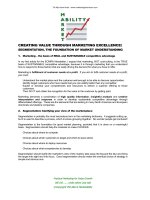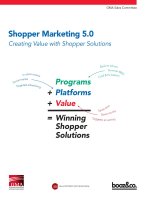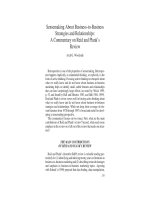PRINCIPLE OF MARKETING REPORT CHAPTER SEVEN: CREATING VALUE FOR TARGET CUSTOMERS
Bạn đang xem bản rút gọn của tài liệu. Xem và tải ngay bản đầy đủ của tài liệu tại đây (519.86 KB, 15 trang )
Group 6
Hoa Sen University
MINISTRY OF EDUCATION & TRAINING
HOA SEN UNIVERSITY
FALCUTY OF ECONOMICS AND COMMERCE
PRINCIPLE OF MARKETING REPORT
CHAPTER SEVEN: CREATING VALUE FOR TARGET CUSTOMERS
Name of product
:
Nescafé 3in1
Class
:
MK 203DV01 - 0800
Group
:
6
<October 2015>
Chapter 7: Creating value for target customers
Page i
Group 6
Hoa Sen University
ACKNOWLEDGMENTS
I would like to thank our supervisors in this subject for having opened our mind with
many valuable lessons in studying marketing principles and also gave us the
opportunities to develop our knowledge in real product research.
Besides, we would like to thank all our classmates, especially those groups who have
presented, for giving us many useful experiences.
Many thanks for all your help and best regard.
Chapter 7: Creating value for target customers
Page ii
Hoa Sen University
Chapter 7: Creating value for target customers
Group 6
Page iii
Group 6
Hoa Sen University
CONTENT
Chapter 7: Creating value for target customers
Page iv
Hoa Sen University
Group 6
1. Introduction to Nescafe 3in1
1.1.Background
Nescafé is a brand of instant coffee made by Nestlé. Nestlé’s coffee powder was
introduced in Switzerland in 1983 after being developed 8 years by Max Rudolf
Morgenthaler.
Nescafe 3in1, which is sweet white coffee with comfortable aroma and full-flavour
taste, is one of best-selling coffee products of Nescafe. Nescafe 3in1 has come to
Viet Nam since 1997. It has 2 types of coffee: regular and rich. Nescafe 3in1’s main
slogan is: “It all starts with a Nescafe”. In the last few years, its TVC in Vietnam also
stresses in “100% made from coffee beans of Viet Nam”.
1.2.Product categories
These are 2 types of Nescafe 3in1 in Vietnam: regular and rich.
Chapter 7: Creating value for target customers
Page 1
Hoa Sen University
Group 6
2. Instant coffee market segmentation
The growth of robusta is not enough for Vietnam. It is mean the demand for instant
coffee has growth faster than production.
We have collected and managed information about coffee market in Vietnam in
internet based on the theory that we learned in the last period. With four
segmentations: geographic segmentation, demongraphic segmentation, psychographic
segmentation and behavioral segmentation, coffee market became much easier to
understand.
2.1.Geographic segmentation
Geographic segmentation is a segmentation divided on the basis of geography.
Coffee market in Vietnam can be divided by geographical area, such as Hanoi
Capital region or Ho Chi Minh city area. It also can be divided into urban or rural
segments.
2.2.Demographic segmentation
Demographic segmentation is a market segmentation according to age, race, gender,
religion, income, family size, occupation, ethnictity and education. These factors
make the standard for recognizing customers and estimating the market size
effectively even when other segmentations change for some reasons.
In coffee market in Vietnam, we only do research in age, gender, income and
occupation.
Age: Consumer needs and wants change with age. These are 4 stages that have the
need in intant coffee: Age 18-22, 23-29, 30-40, 40-50.
Gender: Dividing the market into smaller group based on sex. There are some kind
of strong coffee which usually used for man (like Nescafe Viet) and coffee with
collagen for woman (like G7 Passiona).
Income: Dividing the market into different groups based on how much money one
person (family) makes a month. There are three groups:
Low: 2.1 – 2.9 million dong/month
Medium: 4.3 – 5.1 million dong/month
High: 7.5 – 8.7 million dong/month
Chapter 7: Creating value for target customers
Page 2
Hoa Sen University
Group 6
Occupation: Drinking hobby is affected most by consumer jobs. There are: Student,
Employee, Employer, Worker, Peasant,…
2.3.Psychographic segmentation
Psychographic segmentation is divided according to personality characteristics,
lifestyle, or social class.
Instant coffee intended for younger and busy people. They like convinience and
quickness, who is officer and students or stress working people. Besides, people also
drink coffee to finding relaxation and motivation for a fresh new day. There are some
kind of coffee that is produced only for man, showing high class and strength or only
for woman, with beauty factors. Whenever we are happy or sad, we can have a cup of
coffee to calm ourselves down and make the right decision.
2.4.Behavioral segmentation
Behavioral segmentation divides buyers into groups based on their knowledge,
attitudes, uses, or responses to a product.
Occasions: the buyers need buy coffees when they have demands, times and moneys
to pay them. So, the company should produce much more coffees in the end of year.
Because this time is that they focus on Tet’s holiday and their demands buy the
coffees are more than all other days in year.
Benefits sought: needless to say, drinking a lot of coffees that contains much cafein
will affect to skin, eyes and makes them stress. So, the company will show new
product which contains less cafein for woman
User status: identifying the customers will make them more maximum
advertisements. For expamle, for coffee roasters, they sometimes use on home and
are nearly man who like strong coffee and coffee 3 in 1 that sometimes be used by
students, officers, girls who want to faster and more convinient.
Usage rate: the company researches markets in order to innovate products which are
different with others on market. For instance, the coffee company creates a lot of
product with different tastes which contains smell typical Vietnamese. They divide
many groups that usually buy their product. Man are potential customers of Coffee
market. So, the company should more advertise for man than others.
Chapter 7: Creating value for target customers
Page 3
Hoa Sen University
Group 6
3. Selecting target market segments
Market segmentation is divided into smaller group with distinct needs, characteristic,
or psychographic who might require separate products or marketing mixes.
The target market is a set of buyers sharing common needs or characteristics that the
company decide to serve.
Depend on the market segmentation the target consumer of Nescafe 3in1 are: Urban
consumer and core audience aged 18-40. It means the target aim at people who are
young and busy with work, do not have time to enjoy a cup of coffee but also with
those who are looking for relaxation and want to enjoy their days. This target is
suitable for people living in the city. Because in the city, lives are always busy and
stressful so that people want things to be served quickly, especially the youth
nowadays, only like things served fast. But on the contrary, when people have
freetime, they would rather drink coffee and chat with their friends for hours, even for
a day. In Vietnam, Nescafe 3in1 succeed in taste and aroma of the coffee. Gout of
Vietnamese people is more charming than others.
The strategic objective is developing worldwide supplying net of corporation. The
strategy that helps Nescafe 3in1 succeed is "When in Rome, do as the Romans do".
The company understood the consuming habit of Vietnamese people and also the
lifestyle of them to make the product become suitable.
4. Potential Customers
In psychological:
Vietnamese people would prefer products imported than product made in Vietnam. So
Nescafe can focus on activities related to the pride of Vietnamese history like it used
to do such as introduction to the North of Viet Nam the new product named 1000
years Thăng Long anniversary, 12/2008 nestle impressed people when the show the
biggest VietNam map made from coffee bean at Buon Ma Thuat coffee festival,…
Convenience: introduced a new product that coffee is canned which woule be not
strange to VietNamese people.
Chapter 7: Creating value for target customers
Page 4
Hoa Sen University
Group 6
In geographic:
Nescafe understood that people in the middle and the South are easier to be affected
by promotions and advertisement, after that, the company noticed and attacked the
North because its higher growth of market share and consumers there have preferred
coffee than tea which is traditional drink)
General director – M.rPierre gave Viet Nam map made from coffee bean to
commerce department of tourism in Dak Lak province
Chapter 7: Creating value for target customers
Page 5
Group 6
Hoa Sen University
Nescafe Cans in Malaysia
Potential customers: those who really want to have Nescafe 3in1and their financial
capacity is enough to buy it. Besides, demographic, behaviours are the two main
segments, the company based on the 2 others to attrached consumers in the North
having patriot well and so do the men having strong lifestyle.
5. Positioning Map
Product posittion is the way the product is defined by consumers on important
attributes-the place the product occupies in consumer’s mind relative in competing
products, including perception, impression and feelings. Positioning map also help us
identify where organization can position a new brand
To draw positioning map, first we had to point out Nescafe 3in1’s main opponents:
G7 3in1 and Vinacafe. On the whole relevant attributes, we decided to take two
dimension price and taste which showed us the differences apparantly to evalutate the
products. After that we conducted a survey by using an online form. We asked our
friends to rate from 1 to 5 to scale how good the taste of the product and how suitable
the price of them. This is the result that we received.
Product
Price
Taste
Nescafe 3in1
4.0
3.6
G7 3in1
3.2
3.2
Vinacafe
3.1
3.0
Chapter 7: Creating value for target customers
Page 6
Group 6
Hoa Sen University
We used the number received through the survey to make a map with two axis, one is
price and the other is taste. As we can see, Nescafe 3in1 has been placed in the
highest position of all three. That means it has not only reasonable price but also taste
good. G7 3in1 and Vinacafe are close to each other and both are placed below
Nescafe 3in1. All of them have been placed in the second square of the map.
Reasonable price
Tast
e
goo
d
Tast
e
bad
Unsuitable price
Positioning map of Nescafe 3in1, G7 3in1 and Vinacafe
Chapter 7: Creating value for target customers
Page 7
Hoa Sen University
Group 6
6. Competitive advantages
Competitive advantage in an advantage over competitors gained by offering consumer
greater value, either through lower prices or by providing benefits that justify higher
prices.
First of all, we shall take a look at some opponents of Nescafe 3in1: G7 3in1 and
Vinacafe 3in1. These two have been shared the coffee marketshare with Nestcafe
3in1. Compare to them, Nestcafe 3in1 have the advantage of being a well-known
brand all over the world.
Second of all, Nestle coporation first allowed to produce product in 1998 and since
then it has strongly become more and more familiar with many Vietnamese families,
the reason for this is because they know how to fit in in Vietnam, Nestle has always
been trying to reach customer’s satisfaction with its slogan: Number one brand in the
world, VietNam’s taste. Showing their try to compare with G7- a VietNam’s coffee
brand.
The third advantage of Nestcafe 3in1 is the recognition of nutition quality and various
flavor. Compare to Vinacafe it has two different flavor which make customer prefer
their product to Vinacafe.
It also has loyal customer for Nestle’s products so whenever it comes to make a
coffee choice among them three, Nestcafe always came as the first choice.
The marketing agency of Nestle is very stong and understanding VietNamese, that’s
why they’ve come up with the plan using VietNamese pride of their country into their
product marketing campaign.
Chapter 7: Creating value for target customers
Page 8
Group 6
Hoa Sen University
CONCLUSION
Going through the research, we got many helpful knowledge and experiences for
ourselves, especially we can understand more thorough about Nescafe 3in1 product. We
not only had chance to put theories learning at university into practice, but also got many
lessons about how to worked with others, which were important in life and career.
Chapter 7: Creating value for target customers
Page 9
Group 6
Hoa Sen University
REFERENCE
Diên Vỹ (30/04/2014), Cà phê hòa tan và cuộc chiến tranh giành thị phần, edited October
20th, 2015, from />‘Chapter 7: Creating value for target customer’, in Kotler, Philip & Armstrong, Gary,
Principles Of Marketing 14 edition, published by Bookshop-Loc, page
Positioning map-Marketing thought, edited in Ferbruary 25,
/>
Chapter 7: Creating value for target customers
2013,
from
Page 10
Hoa Sen University
Group 6
Chapter 7: Creating value for target customers
Page 11









